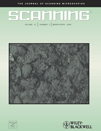Correcting for 3D distortion when using backscattered electron detectors in a scanning electron microscope
Abstract
A variable pressure scanning electron microscope (VPSEM) can produce a topographic surface relief of a physical object under examination, in addition to its two-dimensional (2D) image. This topographic surface relief is especially helpful when dealing with porous rock because it may elucidate the pore-space structure as well as grain shape and size. Whether the image accurately reproduces the physical object depends on the management of the hardware, acquisition, and postprocessing. Two problems become apparent during testing: (a) a topographic surface relief of a precision ball bearing is distorted and does not correspond to the physical dimensions of the actual sphere and (b) an image of a topographic surface relief of a Berea sandstone is geometrically tilted and topographically distorted even after standard corrections are applied. The procedure presented here is to ensure the veracity of the image, and includes: (a) adjusting the brightness and contrast levels originally provided by the manufacturer and (b) tuning the amplifiers of the backscatter detector plates to be equal to each other, and producing zero voltage when VPSEM is idle. This procedure is tested and verified on the said two physical samples. SCANNING 31: 59–64, 2009. © 2009 Wiley Periodicals, Inc.




